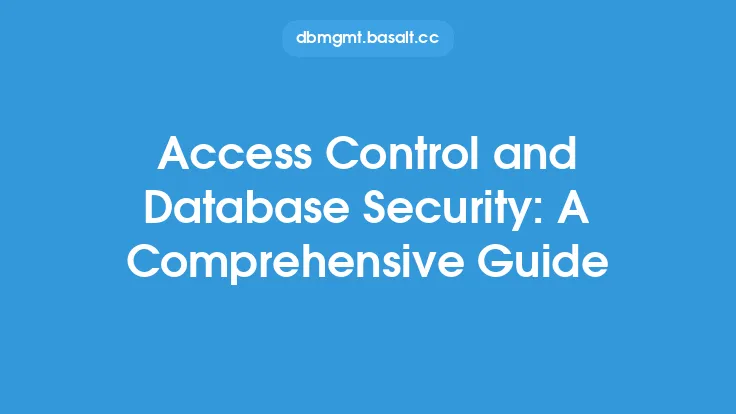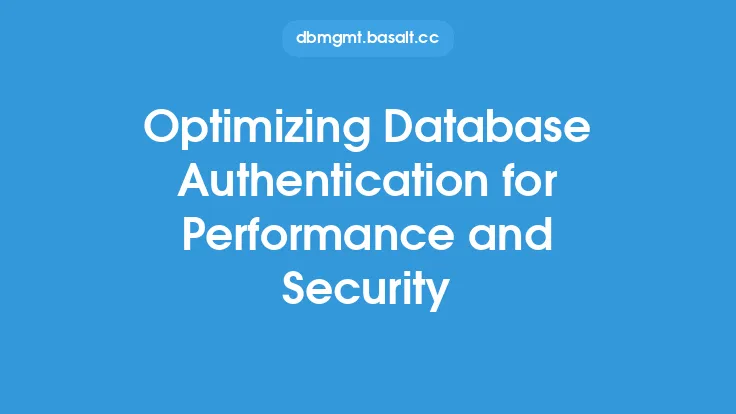When designing and implementing access control mechanisms for databases, it's essential to strike a balance between security, performance, and usability. Access control is a critical component of database security, as it ensures that sensitive data is only accessible to authorized users and applications. However, overly restrictive access control mechanisms can negatively impact database performance and usability, leading to frustration and decreased productivity for users. In this article, we'll explore the challenges of balancing access control with database performance and usability, and discuss strategies for achieving this balance.
Introduction to Access Control Mechanisms
Access control mechanisms are designed to regulate access to database resources, such as tables, views, and stored procedures. These mechanisms can be based on various factors, including user identity, role, privilege, and context. Common access control mechanisms include authentication, authorization, and auditing. Authentication verifies the identity of users and applications, while authorization determines the level of access granted to authenticated users. Auditing involves tracking and logging access to database resources, allowing for monitoring and analysis of access patterns.
Performance Considerations
Database performance is a critical factor in access control design. Overly complex access control mechanisms can introduce significant overhead, leading to decreased query performance and increased latency. This can be particularly problematic in high-transactional databases, where every millisecond counts. To mitigate this, access control mechanisms should be designed to minimize overhead, using techniques such as caching, indexing, and optimized query plans. Additionally, access control mechanisms should be integrated with existing database performance monitoring and optimization tools, allowing for real-time monitoring and tuning of access control-related performance issues.
Usability Considerations
Usability is another essential factor in access control design. Access control mechanisms should be intuitive and easy to use, minimizing the administrative burden on database administrators and users. This can be achieved through the use of user-friendly interfaces, automated workflows, and streamlined access request processes. Additionally, access control mechanisms should provide clear and concise feedback to users, ensuring that they understand the reasons for access denials or restrictions. By prioritizing usability, organizations can reduce the risk of access control-related errors and improve overall user satisfaction.
Balancing Access Control with Performance and Usability
To balance access control with database performance and usability, organizations should adopt a holistic approach that considers multiple factors. This includes:
- Implementing least privilege access control, where users and applications are granted only the necessary privileges to perform their tasks.
- Using role-based access control, where users are assigned to roles that define their access levels and privileges.
- Implementing attribute-based access control, where access decisions are based on user attributes, such as department, job function, or security clearance.
- Using encryption and masking to protect sensitive data, reducing the need for complex access control mechanisms.
- Implementing automated access request and approval workflows, streamlining the access management process and reducing administrative overhead.
- Providing user-friendly interfaces and clear feedback to users, minimizing errors and improving overall user satisfaction.
Technical Implementation
From a technical perspective, balancing access control with database performance and usability requires careful consideration of database design, configuration, and optimization. This includes:
- Using indexing and caching to optimize query performance and reduce access control-related overhead.
- Implementing connection pooling and load balancing to distribute workload and improve responsiveness.
- Using stored procedures and views to encapsulate complex access control logic and improve performance.
- Implementing data encryption and masking to protect sensitive data and reduce the need for complex access control mechanisms.
- Using database auditing and logging to track access patterns and identify potential performance bottlenecks.
Best Practices and Recommendations
To ensure a balanced approach to access control, performance, and usability, organizations should follow best practices and recommendations, including:
- Conducting regular access reviews and audits to ensure that access control mechanisms are aligned with business requirements and security policies.
- Implementing automated access request and approval workflows to streamline the access management process and reduce administrative overhead.
- Providing user-friendly interfaces and clear feedback to users, minimizing errors and improving overall user satisfaction.
- Using encryption and masking to protect sensitive data, reducing the need for complex access control mechanisms.
- Monitoring and optimizing database performance regularly, using tools and techniques such as indexing, caching, and query optimization.
Conclusion
Balancing access control with database performance and usability is a complex challenge that requires careful consideration of multiple factors. By adopting a holistic approach that prioritizes security, performance, and usability, organizations can ensure that their access control mechanisms are effective, efficient, and easy to use. By following best practices and recommendations, and using technical implementation strategies, organizations can achieve a balanced approach to access control, protecting sensitive data while improving database performance and usability.





